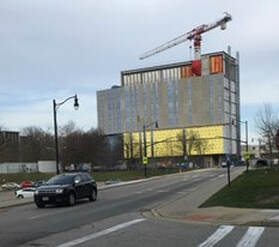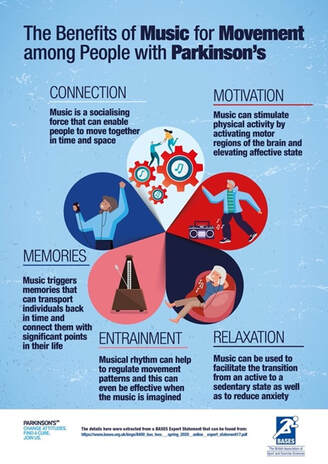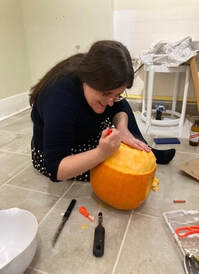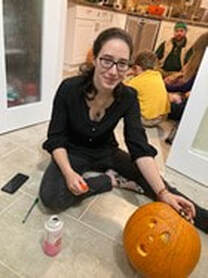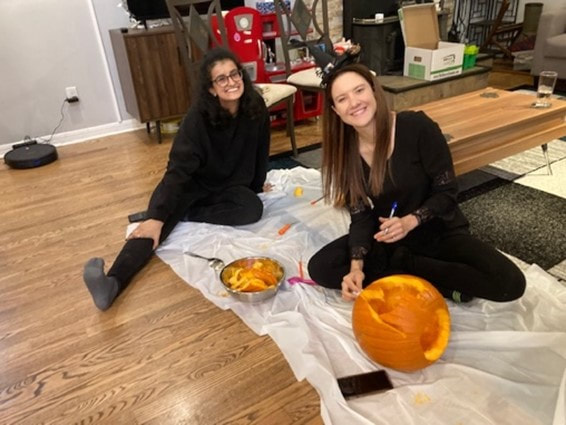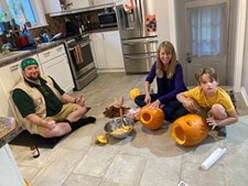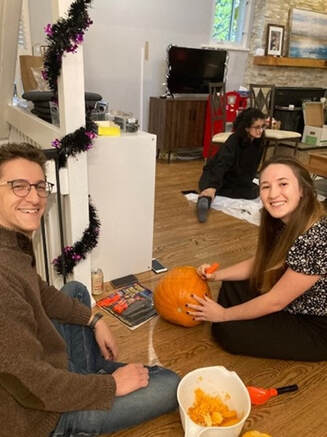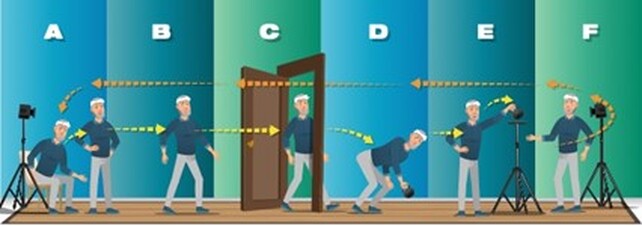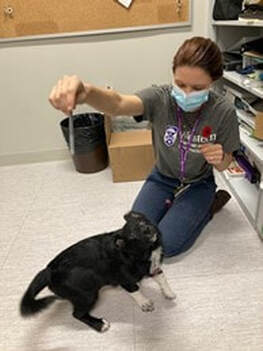Guest post by Dawn Rose
| The sun was shining on the glowing green, amber and yellow trees as I found my way to the new Western Interdisciplinary Research Building (WIRB) to visit Grahn Lab on 1st October 2021. This Scientific Exchange visit was funded by the Swiss National Science Foundation (SNF) for my new role as a researcher at the Lucerne University of Applied Sciences and Arts in Switzerland |
However, I first visited the Brain and Mind Institute as a post doc in April 2017. The WIRB was only half finished then - and wow! - it is impressive in its final glory. It was so great to be greeted at the outdoor coffee morning by the lovely Denise Soanes, who seems to have the uncanny ability to remember everyone and make us all feel so welcome!
My first visit led to a wonderful collaborative study with Dr Jessica Grahn and Dr Dan Cameron which explored spontaneous motor tempo in different movement modalities (finger tapping, toe tapping and stepping on the spot) in people with Parkinson's compared to older and younger neurotypical adults (see Rose et al., 2020). The study confirmed that finger tapping as a paradigm demonstrates Parkinson's symptoms (i.e., higher variability) but showed that people with Parkinson's were faster than older and younger controls in all the different movement modalities. The findings suggested that it should not be taken for granted that the slower rates observed in typical Parkinson gait measures are not necessarily apparent in other movement behaviours.
This 6 week visit was funded by an SNF Scientific Exchange grant which supports international collaborations. During this time, we aimed to explore the feasibility of measuring the effects of musical imagery on gait. Musical imagery is the phenomena whereby a person can either imagine or remember a piece of music such as a song inside their minds. Such experiences can be voluntary or involuntary (for example, a catchy advertising jingle might end up as an unwelcome earworm!). Heard music in comparison is when a person listens to live or recorded music such as at a concert, or on the radio or via a personal music device.
This 6 week visit was funded by an SNF Scientific Exchange grant which supports international collaborations. During this time, we aimed to explore the feasibility of measuring the effects of musical imagery on gait. Musical imagery is the phenomena whereby a person can either imagine or remember a piece of music such as a song inside their minds. Such experiences can be voluntary or involuntary (for example, a catchy advertising jingle might end up as an unwelcome earworm!). Heard music in comparison is when a person listens to live or recorded music such as at a concert, or on the radio or via a personal music device.
Previous studies have shown how music can be help some people with Parkinson's to improve their gait (e.g., Nombela, Hughes, Owen, & Grahn, 2013; Thaut & Abiru, 2010). However, this strategy may be underpinned by a person's ability to detect the beat (Dalla Bella et al., 2017). Therapeutic approaches such as rhythmic auditory stimulation can be effective in lengthening or slowing strides. For others though, music can act as a compromising distraction that reduces their ability to focus on walking (Brown & Marsden, 1991). Linked to this issue, being able to access music cues in real life situations (such as when going shopping) may be problematic as wearing headphones in urban situations can lead to attention blindness (Mwakalonge, Siuhi, & White, 2015) thereby potentially increasing risk factors associated with reduced ability to navigate functional activities in everyday life as observed in people with movement disorders.
| However, during our work with people with Parkinson's we have heard of many anecdotes about imagining songs or parts of songs to help the person get from A to B. In my other studies comparing metronomes (a bland beeping sound) with various types of music in terms of cueing potential, it became clear that music rather than metronomes helped people to keep going when the actual stimuli presentation stopped (we used a repeated synchronization-continuation paradigm to observe re-synchronization effects - see Rose et al 2019). Other studies have shown that imagining singing can improve gait for people with Parkinson's (Harrison, Horin, & Earhart, 2019; Satoh & Kuzuhara, 2008), and it has been suggested that this is a way forward as a strategy for Parkinson's rehabilitation (Grahn & Watson, 2013; Schaefer, 2014). |
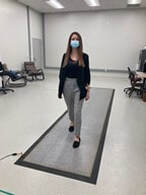
Jessica Grahn and the members of Grahn Lab have worked hard to uncover not only which music matters most in terms of cueing, but how to measure such effects using a pressure sensitive gait mat (Leow, Parrott, & Grahn, 2014). Ready et al., 2019). Here you can see Chantal Rochon, the wonderful Grahn Lab manager showing the mat in its new home.
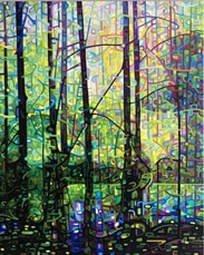
As you can imagine from seeing the mask in the last picture, the Covid-19 safety measures in place meant we were not able to conduct the study with people with Parkinson's at the time of my visit. However, we were able to develop the protocol through several stages of pilot testing. During this time, I was also able to speak with Professor Ingrid Johnsrude, the Director of the BMI about the study. She was interested in which type of stimuli we were planning to use to induce endogenous cueing. She suggested we consider the importance of conation in terms desire to learn. This insight really helped me think about the importance of 'vocables' in music teaching - the use of individualised rhymes or melodies to help students remember a musical phrase or rhythmic pattern (for drummers the phrase paradiddle will resonate here, but most musicians learn 16th notes from some 4 syllable word such as caterpillar).
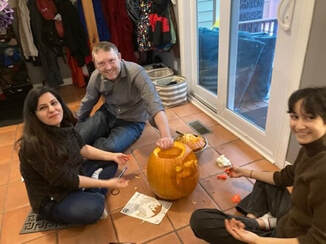
I was so grateful for the opportunity to try out various phrases with the whole Grahn Lab group - but I have to give special thanks to two awesome people for all their help in setting up the study:
Chantal Rochon (Lab manager extraordinaire, pictured above on the gait mat) for all her help settling me in, sorting out the ethics, setting up the gait mat testing, and being the No 1 guinea pig trying it all out!
Ellie Smallman (2nd year Undergraduate, pictured smiling far right) for all her attention and dedication to helping me complete the protocol and for her and Carol Atta's excellent work conducting the data collection in the coming Spring.
Enormous thanks also to Rennee-Marie Ragguett for training us all to use the Gait Mat :-)
Chantal Rochon (Lab manager extraordinaire, pictured above on the gait mat) for all her help settling me in, sorting out the ethics, setting up the gait mat testing, and being the No 1 guinea pig trying it all out!
Ellie Smallman (2nd year Undergraduate, pictured smiling far right) for all her attention and dedication to helping me complete the protocol and for her and Carol Atta's excellent work conducting the data collection in the coming Spring.
Enormous thanks also to Rennee-Marie Ragguett for training us all to use the Gait Mat :-)
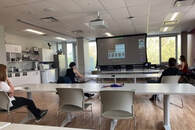
As lab meetings were being conducted in hybrid mode (see picture), this was actually a great opportunity to invite speakers from around the world to share their latest work informally, as ordinarily the travel involved would prohibit such talks. On this occasion, I was able to introduce Professor Olivier Senn, who shared our Preliminaries to a Psychological Model of Musical Groove research and demonstrated the Lucerne Groove Research Library to Grahn Lab, who seemed very interested in the potential of such well documented drum and bass stimuli for future studies.
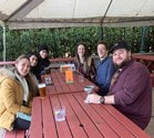
Being part of Grahn Lab is a social as well as scholarly experience. At this time, we were still able to all meet in the infamous Grad Bar, albeit outside. Here you can see Justin Hopper celebrating his successful master’s viva drinking from the Goblet of Knowledge! Other fabulous and fun lab members pictured here from left to right are:
Marina Emerick, Riya Sidhu, Rebekka Lagacé-Cusiac, Chantal Rochon, and Josh Hoddinott).
Marina Emerick, Riya Sidhu, Rebekka Lagacé-Cusiac, Chantal Rochon, and Josh Hoddinott).
During my visit, the Covid-19 restrictions eased and by the end of October we were all able to join Jessica at her house for a Hallowe'en pumpkin carving party. I had never carved a pumpkin before (for some reason we only ever did turnips in our house growing up?!) - so I did some homework and came up with a plan...
NeuroPumpkin had to be born, but I knew I couldn't do it alone! Luckily, my teammates Ana Luisa Pinho and Rebekka Lagacé-Cusiac were proper neuroscientists, and we were able to make not one, but two awesome submissions to the competition.
NeuroPumpkin had to be born, but I knew I couldn't do it alone! Luckily, my teammates Ana Luisa Pinho and Rebekka Lagacé-Cusiac were proper neuroscientists, and we were able to make not one, but two awesome submissions to the competition.
In fact, aside from learning about the gait mat and taking the imagery study to the next level in terms of preparation, one of the most important lessons I learned on my trip was how Jessica (and Chantal) invest so much in making Grahn Lab an awesome place to work and learn.
I think this ethos helps keep science creative and really honours the young people dedicating so much of their time to studying, not only learning the techniques but also pushing the boundaries by asking questions and taking the time to try out new ideas. Jessica is really a powerhouse here, demonstrating through transparency in process that accessing knowledge is underpinned by curiosity and challenge. My visit to Grahn Lab made me feel hopeful about the future in a time of uncertainty. I mean look at this lovely lot of pumpkins!
I think this ethos helps keep science creative and really honours the young people dedicating so much of their time to studying, not only learning the techniques but also pushing the boundaries by asking questions and taking the time to try out new ideas. Jessica is really a powerhouse here, demonstrating through transparency in process that accessing knowledge is underpinned by curiosity and challenge. My visit to Grahn Lab made me feel hopeful about the future in a time of uncertainty. I mean look at this lovely lot of pumpkins!
This project is important because it is the first stage in developing new measurement protocols for a larger project which will co-create a new music and movement intervention for and with people with Parkinson's. The schema below shows how we will integrate the pressure sensitive gait mat with a motion capture system to help us quantify functional activity and clinical measures throughout a randomised control trial in the next few years.
I am pleased to say that Jessica has kindly agreed to be part of the sounding board for that project, and this will help us continue and broaden our collaboration as we involve therapeutic practitioners, medical professionals, and of course, people with Parkinson's in the process. Hopefully we can do another Blog about this in the not too distant future.
I am pleased to say that Jessica has kindly agreed to be part of the sounding board for that project, and this will help us continue and broaden our collaboration as we involve therapeutic practitioners, medical professionals, and of course, people with Parkinson's in the process. Hopefully we can do another Blog about this in the not too distant future.
Thank so much for having me to visit!
REFERENCES
Brown, R. G., & Marsden, C. D. (1991). Dual task performance and processing resources in normal subjects and patients with Parkinson's disease. Brain, 114(1), 215-231.
Dalla Bella, S., Benoit, C. E., Farrugia, N., Keller, P. E., Obrig, H., Mainka, S., & Kotz, S. A. (2017). Gait improvement via rhythmic stimulation in Parkinson’s disease is linked to rhythmic skills. Scientific Reports, 7, 42005.
Harrison, E. C., Horin, A. P., & Earhart, G. M. (2019). Mental Singing Reduces Gait Variability More Than Music Listening for Healthy Older Adults and People With Parkinson Disease. Journal of Neurologic Physical Therapy, 43(4), 204-211.
Leow, L. A., Parrott, T., & Grahn, J. A. (2014). Individual differences in beat perception affect gait responses to low-and high-groove music. Frontiers in Human Neuroscience, 8, 811.
Nombela, C., Hughes, L. E., Owen, A. M., & Grahn, J. A. (2013). Into the groove: can rhythm influence Parkinson’s disease?. Neuroscience & Biobehavioral Reviews, 37(10), 2564-2570.
Mwakalonge, J., Siuhi, S., & White, J. (2015). Distracted walking: Examining the extent to pedestrian safety problems. Journal of Traffic and Transportation Engineering (English edition), 2(5), 327-337.
Ready, E. A., McGarry, L. M., Rinchon, C., Holmes, J. D., & Grahn, J. A. (2019). Beat perception ability and instructions to synchronize influence gait when walking to music-based auditory cues. Gait & posture, 68, 555-561.
Rose, D., Delevoye-Turrell, Y., Ott, L., Annett, L. E., & Lovatt, P. J. (2019). Music and Metronomes Differentially Impact Motor Timing in People with and without Parkinson’s Disease: Effects of Slow, Medium, and Fast Tempi on Entrainment and Synchronization Performances in Finger Tapping, Toe Tapping, and Stepping on the Spot Tasks. Parkinson’s Disease, 2019.
Rose, D. C., Cameron, D., Lovatt, P., Grahn, J., & Annett, L. (2020). Comparing spontaneous motor tempo when finger tapping, toe tapping and stepping on the spot in people with and without Parkinson’s disease. Journal of Movement Disorders.
Satoh, M., & Kuzuhara, S. (2008). Training in mental singing while walking improves gait disturbance in Parkinson’s disease patients. European Neurology, 60(5), 237-243
Schaefer, R. S. (2014). Auditory rhythmic cueing in movement rehabilitation: Findings and possible mechanisms. Philosophical Transactions of the Royal Society B: Biological Sciences, 369(1658), 20130402.
Thaut, M. H., & Abiru, M. (2010). Rhythmic auditory stimulation in rehabilitation of movement disorders: a review of current research. Music Perception: An Interdisciplinary Journal, 27(4), 263-269.
Brown, R. G., & Marsden, C. D. (1991). Dual task performance and processing resources in normal subjects and patients with Parkinson's disease. Brain, 114(1), 215-231.
Dalla Bella, S., Benoit, C. E., Farrugia, N., Keller, P. E., Obrig, H., Mainka, S., & Kotz, S. A. (2017). Gait improvement via rhythmic stimulation in Parkinson’s disease is linked to rhythmic skills. Scientific Reports, 7, 42005.
Harrison, E. C., Horin, A. P., & Earhart, G. M. (2019). Mental Singing Reduces Gait Variability More Than Music Listening for Healthy Older Adults and People With Parkinson Disease. Journal of Neurologic Physical Therapy, 43(4), 204-211.
Leow, L. A., Parrott, T., & Grahn, J. A. (2014). Individual differences in beat perception affect gait responses to low-and high-groove music. Frontiers in Human Neuroscience, 8, 811.
Nombela, C., Hughes, L. E., Owen, A. M., & Grahn, J. A. (2013). Into the groove: can rhythm influence Parkinson’s disease?. Neuroscience & Biobehavioral Reviews, 37(10), 2564-2570.
Mwakalonge, J., Siuhi, S., & White, J. (2015). Distracted walking: Examining the extent to pedestrian safety problems. Journal of Traffic and Transportation Engineering (English edition), 2(5), 327-337.
Ready, E. A., McGarry, L. M., Rinchon, C., Holmes, J. D., & Grahn, J. A. (2019). Beat perception ability and instructions to synchronize influence gait when walking to music-based auditory cues. Gait & posture, 68, 555-561.
Rose, D., Delevoye-Turrell, Y., Ott, L., Annett, L. E., & Lovatt, P. J. (2019). Music and Metronomes Differentially Impact Motor Timing in People with and without Parkinson’s Disease: Effects of Slow, Medium, and Fast Tempi on Entrainment and Synchronization Performances in Finger Tapping, Toe Tapping, and Stepping on the Spot Tasks. Parkinson’s Disease, 2019.
Rose, D. C., Cameron, D., Lovatt, P., Grahn, J., & Annett, L. (2020). Comparing spontaneous motor tempo when finger tapping, toe tapping and stepping on the spot in people with and without Parkinson’s disease. Journal of Movement Disorders.
Satoh, M., & Kuzuhara, S. (2008). Training in mental singing while walking improves gait disturbance in Parkinson’s disease patients. European Neurology, 60(5), 237-243
Schaefer, R. S. (2014). Auditory rhythmic cueing in movement rehabilitation: Findings and possible mechanisms. Philosophical Transactions of the Royal Society B: Biological Sciences, 369(1658), 20130402.
Thaut, M. H., & Abiru, M. (2010). Rhythmic auditory stimulation in rehabilitation of movement disorders: a review of current research. Music Perception: An Interdisciplinary Journal, 27(4), 263-269.


